
A couple of years ago, I acquired a collection of vintage 1930’s era vacuum tubes which were designed to be operated from a battery supply. Some had 1.4 volt filaments and some had 2.0 volt filaments. The 1.4 volt tubes were designed for operation from carbon zinc dry cells, while the 2.0 volt tubes were designed for operation on lead acid cells or the long obsolete air cells, both of which put out 2 volts. While I own a few antique radios, I have nothing in my collection that uses any of these tubes. So, I decided to come up with some project that would put them to good use.
My intention was to build a battery powered radio, and to find a way to use the 2 volt filament tubes powered from readily available batteries. I decided that the simplest approach would be to use tubes with identical filament current ratings and then connect them with the filaments in series. With this in mind, I chose tubes with 60 mA filaments, and limited the design to a three tube circuit. For tubes, I picked a 1D7G pentagrid converter, a 1D5GP pentode, and a 1H4 triode.
My intention was to use the 1D7 in its standard application to mix the incoming RF signal down to the intermediate frequency of 455 kHz, then use the 1D5 as a regenerative detector, providing both IF gain and selectivity, as well as audio detection. The 1H4 would then be used as a final audio amplification stage. Receiver designs like this were fairly common many years ago, and gave reasonable performance with relatively few parts. Two such examples are the Philco models 80 and 84 (though these were AC powered and therefore included a fourth tube as rectifier). There were others as well. I decided to base my design on a circuit by George Grammer that appeared in the February 1941 issue of QST magazine. I have redrawn that circuit, and it is shown here:
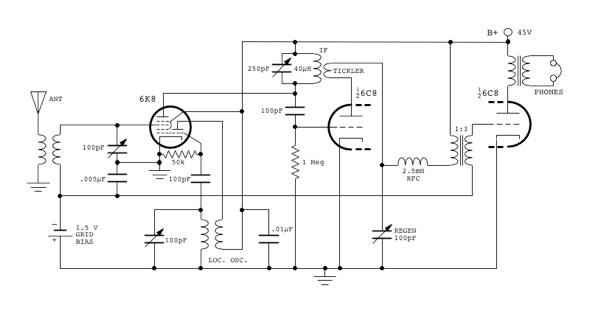
It should be pointed out that this circuit was not intended for a battery supply and uses tubes which draw a lot of heater current. But I hoped that it would be adaptable to battery tubes. The circuit is quite simple, and does not require any hard to find coils. Except for the 2.5 mH choke, all of the coils were intended to be hand wound by the builder, including the IF coil, and detailed construction information was given. This circuit has received many good reviews over the years, and as such, seemed to be a good basis for the present project.
Filament Wiring
My first concern, was that my chosen tubes were never designed for series filament operation, and there was no guarantee that the filaments would heat evenly. By the 1940’s, radio manufacturers were using newer design battery tubes for portable radios, and series connected filaments, but still included parallel equalizing resistors to keep the filament voltage drops within design limits. This is wasteful of battery power, and so I decided to do some measurements with several tubes to see how the filament voltage varied from tube to tube, with the hope that equalizing resistors would not be required. I connected the filaments of three tubes in series to a variable power supply and brought the voltage up slowly until the highest voltage across any filament reached 2.0 volts.
The results of the first test:
Tube Set #1
1D7 - 2.0 v
1H4 - 1.6 v
1D5 - 1.75 v
Not too promising. So, I swapped out the 1H4 for a different one and then got this result:
Tube Set #2
1D7 - 2.0 v
1H4 - 1.75 v
1D5 - 1.77 v
This is an improvement, but it’s obvious that the 1D7 converter requires the most voltage to reach the design filament current. Unfortunately I didn’t have a spare 1D7 to swap into the circuit. Anyway, this is probably workable as is, but I didn’t want to have to be concerned about hand picking tubes to make sure things stayed in balance. Nor did I want to resort to a power wasting resistor network. As an alternative, I decided to try a series chain of rectifier diodes. Using a string of nine 1N4007 diodes, I connected three across each filament.
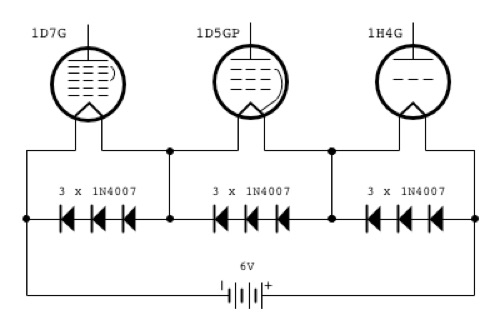
The diode forward voltage being 0.7 volts, each diode group would not start to conduct any significant current until the voltage across the filament reached 2.1 volts, and a total supply of 6.3 volts across all three filaments. This worked very well. The voltage balance across the filaments improved dramatically, and there was surprisingly little overall increase in current due to the diodes.
The results are as follows:
Tube Set #1
Tube w/o D w D 6V tot
---- ----- ---- ------
1D7 2.0 2.0 2.07
1H4 1.6 1.79 1.92
1D5 1.75 1.91 2.02
Tube Set #2
Tube w/o D w D 6V tot
---- ----- ---- ------
1D7 2.0 2.0 2.06
1H4 1.75 1.89 1.95
1D5 1.77 1.92 1.99
Notes:
w/o D - Without diode limiters
w D - With diode limiters and voltage adjusted
until one tube filament reaches 2V
6V tot - With diode limiters and voltage
adjusted until total voltage is 6 volts.
The following picture shows the test setup using the equalizing diodes (difficult to see in the photo) and the resulting filament voltages, in one of the tests.
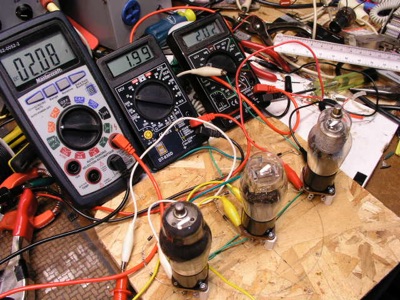
A brand new 6.3 volt (nominal) alkaline lantern battery has an output voltage of close to 6.5 volts, but at that voltage, the increase in current due to diode conduction is not significant, and the voltage across the filaments remained very even. A further benefit of using the diodes is that during warm-up, they protect the filaments from over voltage due to uneven warm-up time between tubes and the considerable difference between cold and hot filament resistance. Consequently, I decided to keep the diodes in the circuit for added protection. As a side note, if this were to have been built 75 years ago, replacement tubes would be relatively inexpensive, and one could likely get by without any equalizing circuit, but nowadays these old tubes are more difficult to find, and deserve a bit more protection, even if silicon diodes aren’t period correct.
A side benefit of wiring the filaments in series is that it provides suitable negative grid bias for the different tubes without requiring any additional parts or separate voltage sources. The order in which the filaments are arranged is important however. The audio output tube requires the most negative grid bias, and therefore the audio tube filament is connected to the positive side of filament supply, putting the filament an average of +5 volts above ground and consequently the grid is biased at –5 volts with respect to the filamentary cathode. The converter tube requires less bias than the audio tube, and is next in the chain giving a grid bias of –3 volts. The detector tube requires the least bias, and is the last in the chain giving a grid bias of –1 volt, although the choice of grid leak resistance value will also affect the detector bias voltage.
With the filament supply issues resolved, the next concern was to get the converter stage up and running. Returning to the Grammer circuit, the original article gave detailed directions for winding the various coils, which I felt would help speed up the initial prototyping. While there is no problem in determining the required inductance and number of turns for the resonant windings, there is always a certain amount of guesswork involved in determining the optimum number of feedback turns on the coils. Having this work already done was an attractive feature of this design. Unfortunately, the 6K8 converter tube used in the Grammer circuit is a triode-hexode converter which has different characteristics than my 1D7 pentagrid converter. And in the end, I had to build a separate oscillator test bed, and experiment with the number of feedback windings until I was able to achieve reliable operation. And so, while very little work was saved there, I did get a working converter stage, and moved on to the regenerative detector.
As mentioned earlier, the IF coil is a custom wound unit, which avoids the problem of trying to locate long obsolete commercial parts. Unfortunately, I again ran into a stumbling block. The Grammer receiver was designed for the ham bands and uses a 1600 kHz intermediate frequency. Even though I had plans to make my receiver operate on shortwave bands, I also wanted it to work on the standard medium wave broadcast band. For this, a 1600 kHz IF is not the best choice, and I decided to go with a conventional 455 kHz IF. I soon found that it was not possible simply to change the component values of the IF tank to resonate at 455 kHz and have it work properly. As well, the Grammer circuit used a triode for this stage, and I intended to use the 1D5 pentode. So, in the end, I completely redesigned the regenerative detector stage.
In my parts box, I found a damaged 455 kHz IF transformer. One of the windings was burned. I removed the damaged winding and then added a tickler winding of about a dozen turns. However, I found that connecting both the converter plate and the detector grid to the same point on the IF tank causes so much loading that it was impossible to get proper regeneration. Consequently, gain and selectivity were abysmal. It appeared that I needed to add another winding onto the IF coil. However, as a quick test, I connected the converter plate to the tickler winding in parallel with the detector plate. While this may seem doomed to failure, both the detector plate signal and converter plate signal are very high impedance sources feeding into the low impedance tickler winding. Therefore, it seemed that there might not be too much interaction between the two. As it turned out, that arrangement worked so well, that there was no need to add another winding to the IF coil.
As I am using a pentode for the regenerative detector stage, it’s much easier and simpler to control regeneration by adjusting the screen voltage than by using the bypass variable capacitor. Consequently, I added a potentiometer to the screen grid circuit, to adjust regeneration.
I built the audio amplifier section essentially the same as the Grammer circuit. The first working prototype circuit is shown here.
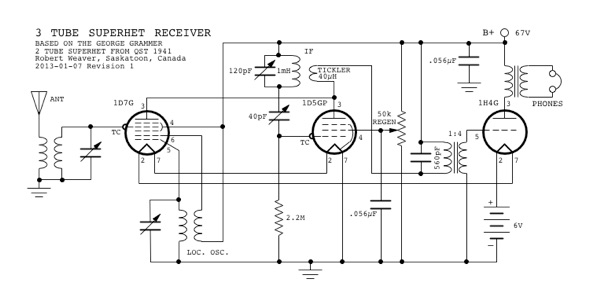
Note that the filament voltage equalizing diodes are not shown in this diagram, but they were in the circuit nevertheless.
As built, it worked acceptably well. I was able to tune in all of the local stations, and with some additional knob twisting, could receive quite a few distant stations. The first tests were encouraging. Sensitivity and selectivity were both quite good. However, there was still much room for improvement.
Starting with the converter stage, the original Grammer circuit used separate variable capacitors for tuning the RF input and the local oscillator. This is inconvenient, and I had a dual gang variable capacitor available. So, I modified the circuit to use the single tuning capacitor. This requires that the local oscillator track the RF stage precisely. The local oscillator must always be 455 kHz above the resonant frequency of the RF input stage. This is accomplished by adding a series padder capacitor and parallel trimmer to the local oscillator gang of variable capacitor. The calculations required for determining the correct values can be quite quite involved. However, I had previously written a tracking calculator program which finds the correct component values for optimum tracking, making this relatively painless. Following, is the output of the tracking calculator showing the characteristic S-shape error curve at optimum tracking. The calculated tracking component values are listed as well:
Because it called for a 25pF trimmer capacitor across the RF tuning capacitor gang, I decided to make this adjustable from the front panel as an RF fine tuning control.
The coil that I used for the local oscillator was wound on an old slug tuned loopstick coil form. Its adjustable ferrite slug allows fine adjustment of the inductance.
The RF coil was wound on an FT82-61 ferrite toroid. The inductance was measured and the number of turns was adjusted to get as close as possible to the design value. However, there is some leeway here because of the RF fine tune trimmer capacitor.
The next item on the list was the regenerative detector. While this was working very well, there is one interesting thing to note: When the tube filaments are cold, and hence, no plate current flowing, then the only DC path between B+ and ground is through the regeneration control potentiometer. In very early battery radios, there was typically no DC path to ground with cold filaments, and so the receiver could be switched on and off simply by switching the filament supply. It may seem like a very minor point, but I decided to see if the ground leg of the regen pot could be disconnected, and still work properly. I found that if I increased the value from 50 k ohms to 1 Megohm, that the regen seemed to work almost as well in a rheostat (2-wire variable resistance) connection. I say almost, because there was a small amount of hysteresis in the adjustment. Here is my prototype at this stage of the design:
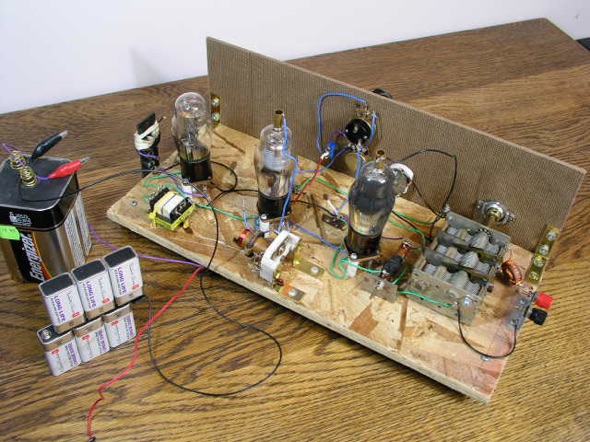
The filament supply is a 6 volt lantern battery, and the plate supply is a series connected set of six 9 volt batteries which gives 54 volts in this case. I later added two more 9 volt batteries increasing the plate supply to 72 volts. Total B+ current is between 12.5 and 14 mA, depending on the setting of the regeneration control. Consequently, the receiver will operate for quite a few hours before any of the batteries need to be replaced.
The front view shows two versions of the regen control with a toggle switch that allows switching back and forth between potentiometer mode and rheostat mode, so that I could compare operation under different operating conditions.
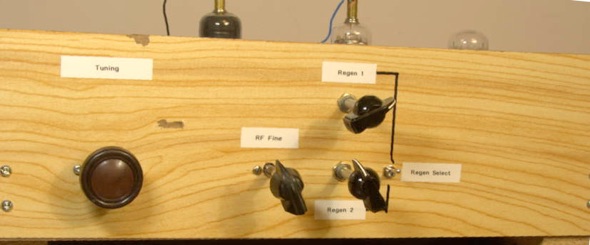
At this stage of construction I made the following video of its operation:
By increasing the regen bypass capacitor value from 0.056 µF to 4.7 µF the hysteresis problem disappeared, but the large capacitance value required the use of an electrolytic type which is subject to leakage current, and therefore there is once again a DC path from B+ to ground. However, it later occurred to me that moving the bypass electrolytic so that it is across the variable resistor, accomplishes the same result, but with no DC path to ground. And so, the circuit was modified accordingly.
Finally, I revisited the audio amplifier stage. The audio output level was quite low, and required the use of fairly sensitive headphones when receiving distant radio stations. The 1H4 triode, with the exception of its filament rating, is electrically identical to the earlier ‘01A tube which is a long way down in the evolutionary chain of amplifying devices. It is classed as a low mu triode, and its mu (amplification factor) is quite low even for low mu tubes. Since I had more than one 1D5 pentode in my collection, I decided to substitute this for the audio tube. There was considerable improvement in audio gain, and so this was used in the final design. Aside from connecting the 1D5 screen grid to B+, the only other circuit changes required was some adjustment to the output transformer primary impedance. However, when listening to local radio stations, the volume has become unpleasantly loud, so I went back and added a volume control to this stage.
The circuit, in its current form, is shown here:
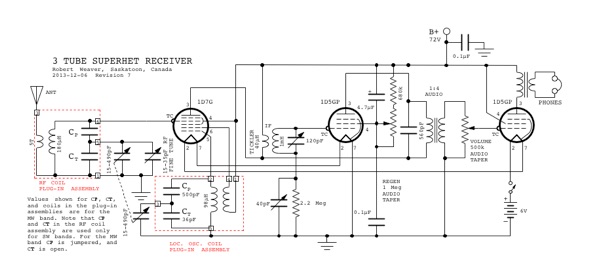
Again, the filament voltage equalizing diodes are not shown. A couple of details not shown on the schematic are specifications for the audio interstage transformer and the output transformer. Typically, in these designs, the interstage transformer has a step up turns ratio of 1:3 with the primary inductance high enough that it doesn’t place too much load on the plate of the detector. Lacking anything else, I used a small 240 to 56 volt power transformer which has a ratio of 1:4.3, and it worked reasonably well, though there are many possible choices here. As for the output transformer, it depends largely on the impedance of the speaker or headphones. When testing with a speaker, I used a Bogen T725 transformer, and chose the primary tap that gave the most output. When using headphones with an impedance of 1200 ohms, I found that a small Xicon 25k:600Ω or a Xicon 10k:500Ω gave good performance. Allowing for the secondary impedance mismatch, the optimum primary impedance is therefore probably somewhere between 24k and 50k. Some experimentation is always required in these situations to get best performance, also bearing in mind that headphone impedance will change considerably across the audio frequency range, so that impedance choices will affect frequency response. For best audio intelligibility one impedance ratio will be optimum, and it may not correspond to the published specifications. All you can do is try different ratios and pick the best one.
One last point: Alert readers will note that there is no signal isolation between the series connected filaments. I had given this some consideration, and expected that it might be necessary to include filament to ground bypass capacitors (or possibly chokes between the filaments). But in testing, I tried it both with and without, and found no difference whatsoever. So, there was no need for them in the final circuit. As I continue to experiment with higher shortwave frequencies, I may need to revisit this. However, up to 6 MHz there is no problem.
With the circuit working to my satisfaction, it was time to give it a thorough test. I entered this set in the 2013 Radioboard DX Contest, and following is my reception log:
Local Freq. Stn. Dist
No. Date Time kHz ID km Location
--- ---- ----- ---- ---- ---- --------
001 2013-07-26 22:15 780 WBBM 1795 CHICAGO, IL, US
002 2013-07-26 22:16 800 CHAB 210 MOOSE JAW, SK
003 2013-07-26 22:30 920 CFRY 624 PORTAGE LA PRAIRIE, MB
004 2013-07-26 22:32 900 CKBI 126 PRINCE ALBERT, SK
005 2013-07-26 22:57 950 CFAM 702 Altona, MB, CA
006 2013-07-26 23:26 1040 WHO 1535 DES MOINES, IA, US
007 2013-07-26 23:26 1040 CKST 1195 VANCOUVER, BC
008 2013-07-26 23:27 1030 KTWO 1030 CASPER, WY, US
009 2013-07-26 23:27 1010 CBR 1 498 Calgary, AB, CA
010 2013-07-26 23:27 1000 KOMO 1243 SEATTLE, WA, US
011 2013-07-26 23:27 990 CBW 687 Winnipeg, MB, CA
012 2013-07-26 23:27 980 CJME 240 REGINA, SK
013 2013-07-26 23:27 970 WDAY 912 FARGO, ND, US
014 2013-07-26 23:27 960 CFAC 513 CALGARY, AB
015 2013-07-26 23:28 940 CJGX 313 Yorkton, SK, CA
016 2013-07-26 23:28 910 CKDQ 475 Drumheller, AB, CA
017 2013-07-26 23:38 1050 CJNB 140 North Battleford, SK, CA
018 2013-07-26 23:42 1060 CKMX 518 Calgary, AB, CA
019 2013-07-26 23:57 1110 KFAB 1464 OMAHA, NE, US
020 2013-07-27 00:04 540 CBK 94 WATROUS, SK
021 2013-07-27 00:07 600 CJWW 12 Saskatoon, SK, CA
022 2013-07-27 00:08 650 CKOM 9 SASKATOON, SK
023 2013-07-27 00:14 740 CBX 478 Edmonton, AB, CA
024 2013-07-27 00:15 750 CKJH 156 Melfort, SK, CA
025 2013-07-27 00:24 1210 CFYM 187 Kindersley, SK, CA
026 2013-07-27 00:25 1200 CJRJ 1200 Vancouver, BC, CA
027 2013-07-27 00:25 1220 CJRB 561 Boissevain, MB, CA
028 2013-07-27 00:26 1130 CKWX 1201 Vancouver, BC, CA
029 2013-07-27 00:29 1140 CHRB 515 High River, AB, CA
030 2013-07-27 00:30 1160 KSL 1326 SALT LAKE CITY, UT, US
031 2013-07-27 00:37 1190 CFSL 353 Weyburn, SK, CA
032 2013-07-27 00:46 1320 CHMB 1199 Vancouver, BC, CA
033 2013-07-27 00:48 1330 CJYM 117 Rosetown, SK, CA
034 2013-07-27 00:56 1570 CKMW 689 Morden, MB, CA
035 2013-07-27 00:59 1540 KXEL 1542 WATERLOO, IA, US
036 2013-07-28 00:35 830 WCCO 1241 MINNEAPOLIS, MN, US
037 2013-07-28 00:45 620 CKRM 242 Regina, SK, CA
038 2013-07-28 00:57 570 CKSW 231 Swift Current, SK, CA
039 2013-07-28 03:18 730 CKDM 455 Dauphin, MB, CA
040 2013-07-28 03:24 720 WGN 1793 CHICAGO, IL, US
041 2013-07-28 04:02 1390 KRRZ 579 MINOT, ND, US
042 2013-07-28 04:28 1520 KKXA 1197 SNOHOMISH, WA, US
043 2013-07-28 04:33 1560 KKAA 953 ABERDEEN, SD, US
044 2013-07-28 04:37 1600 KEPN 1389 LAKEWOOD, CO, US
045 2013-07-28 16:53 770 CHQR 533 Calgary, AB, CA
046 2013-07-28 16:54 830 CKKY 290 Wainwright, AB, CA
047 2013-07-30 01:37 1550 KRPI 1184 FERNDALE, WA, US
048 2013-07-30 01:45 1500 KSTP 1269 ST. PAUL, MN, US
049 2013-07-30 01:47 1510 KGA 924 SPOKANE, WA, US
050 2013-07-30 02:00 1470 KWSL 1323 SIOUX CITY, IA, US
051 2013-07-30 02:27 1420 KTOE 1289 MANKATO, MN, US
052 2013-07-30 02:35 1370 CFOK 531 Westlock, AB, CA
053 2013-07-30 02:42 1320 KELO 1213 SIOUX FALLS, SD, US
054 2013-07-30 02:42 1320 KOZY 1094 GRAND RAPIDS, MN, US
055 2013-07-30 02:45 1290 CFRW 704 Winnipeg, MB, CA
056 2013-07-30 02:51 1310 KNOX 834 GRAND FORKS, ND, US
057 2013-07-30 02:53 1280 CJSL 428 Estevan, SK, CA
058 2013-07-30 02:54 1260 CFRN 497 Edmonton, AB, CA
059 2013-07-30 02:59 1180 KOFI 694 KALISPELL, MT, US
060 2013-07-30 03:06 1080 KRLD 2284 DALLAS, TX, US
061 2013-07-31 01:01 690 CBKF-1 248 GRAVELBOURG, SK
062 2013-07-31 13:29 1070 KATQ 399 PLENTYWOOD, MT, US
063 2013-07-31 13:37 880 CKLQ 553 Brandon, MB, CA
064 2013-07-31 14:30 710 KXMR 733 BISMARCK, ND, US
065 2013-07-31 14:53 660 KEYZ 479 WILLISTON, ND, US
066 2013-07-31 17:47 550 KFYR 480 BISMARCK, ND, US
067 2013-07-31 18:12 560 KMON 664 GREAT FALLS, MT, US
068 2013-07-31 18:13 590 KGLE 406 GLENDIVE, MT, US
069 2013-07-31 23:39 850 KOA 1244 DENVER, CO, US
070 2013-07-31 23:48 700 KALL 1262 NORTH SALT LAKE CITY, UT, US
071 2013-07-31 23:54 1120 KMOX 1702 ST. LOUIS, MO, US
072 2013-08-01 00:02 1130 KBMR 478 BISMARCK, ND, US
073 2013-08-01 00:32 890 WLS 1578 CHICAGO, IL, US
074 2013-08-01 00:36 760 WJR 1819 DETROIT, MI, US
075 2013-08-01 00:55 860 CBKF-2 274 Saskatoon, SK, CA
076 2013-08-01 01:01 930 CJCA 738 Edmonton, AB, CA
077 2013-08-01 01:22 1090 KPTK 1414 SEATTLE, WA, US
078 2013-08-01 01:27 1090 KBOZ 788 BOZEMAN, MT, US
079 2013-08-01 01:41 1250 CHSM 491 Steinbach, MB, CA
All station locations are in Canada or the United States (US locations are indicated as such).
When doing the final construction, I decided to use sockets for the RF and local oscillator coils so that I could build coil sets for different frequency bands. I wasn’t sure how well the 1D7 converter would work at higher frequencies. These battery converter tubes were not known for good performance at shortwave frequencies. However I did manage to locate one commercial receiver design using a 1D7 that had a shortwave band on it. It was sold by Montgomery Ward, models 62-405 and 62-414 (the same circuit and chassis installed in different cabinets). The shortwave band was from 2 to 7 MHz. With that knowledge, I set about making a set of coils to cover the frequency range of 4900 kHz to 6100 kHz. I decided to limit the tuning range to 1200 kHz so that the tuning would not be too touchy. The following picture shows the RF and LO shortwave coils on the left, still in very rough prototype stage, and the finished broadcast band RF and LO coils on the right. (The broadcast band coils are mounted internally in the PVC pipe.)

The trimmer and padder capacitors are built into each coil set so that the tracking adjustments are part of those assemblies, and therefore no adjustments need to be made when the coils are switched. It required a lot of trial and error to get the coils adjusted for proper operation in the shortwave band, mainly because I didn’t have an accurate estimate of stray capacitance in the turned circuits. A rough estimate of stray capacitance is okay for setting up the tuned circuits in the broadcast band, but as we move up in frequency, stray capacitance has a much bigger impact on tuning, and it becomes very important to determine its value accurately. Once this has been done, it’s possible to calculate the correct coil inductance values and then fine tune the components to operate in the desired frequency band. After several days of tweaking coils, I was finally able to get the receiver operating quite well on the 4900 – 6100 kHz band. However, I did encounter some problems with images on shortwave mainly due to less than ideal selectivity of the RF stage and the low IF frequency. There's probably not much that can be done about this without a major redesign of the RF stage.
My current plans are to build additional coil sets for 9500 kHz (31 meters) and 11,700 kHz (25 meters). If they work properly, I may attempt higher frequencies.
For more information on the construction details and how I made the fake vintage looking parts, continue to Part 2.
Continue to:
Three Tube Superhet Part 2